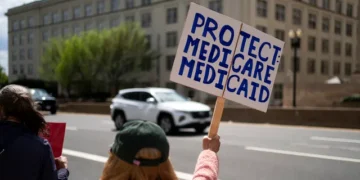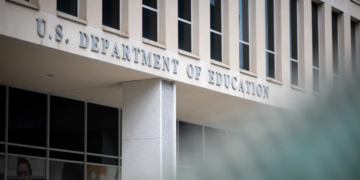Feb 25, 2025 Story by: Editor
The Trump administration is considering significant reductions to programs and staff in the U.S. Department of Education, including executive action to shut down programs not protected by law and urging Congress to dismantle the department entirely.
On Tuesday, the White House confirmed to NPR that the executive action is expected to be issued by the end of the month, aligning with the broad framework of the administration’s plan.
The Wall Street Journal was the first to report on these developments.
This impending executive action follows recent moves by the administration to place dozens of Education Department employees on paid administrative leave without clear explanations. The only justification provided was that the decision stemmed from President Trump’s executive order targeting federal diversity programs.
These actions have unsettled department staff and are expected to be a topic of discussion during the Senate confirmation hearing for Trump’s nominee for education secretary, Linda McMahon, though a date for the hearing has not been set.
The Education Department, which has around 4,400 employees and a $79 billion annual budget, oversees three primary areas: managing approximately $1.6 trillion in federal student loan debt, implementing and enforcing special education laws, and administering Title I, the main federal program aimed at supporting students from low-income backgrounds.
Can Trump Shut Down the Education Department?
While the anticipated executive action may propose deep cuts and call for the closure of the department, shutting it down outright cannot be done through executive authority alone.
The department was established by Congress in 1979, meaning only legislative action can formally dismantle it.
Whether there is sufficient congressional support to close the department remains uncertain. House Republicans have attempted this in the past but were unsuccessful, and the current Republican majority in both chambers is slim.
Additionally, public opinion surveys indicate that most Republicans favor increased federal spending on education rather than cuts.
Can Trump Reduce the Education Department’s Budget?
While some reductions appear feasible, the administration’s ability to make cuts is limited to programs not established by Congress, as those created through legislation are protected by statute.
Key federal funding programs such as Title I, which supports schools in lower-income communities, and the Individuals with Disabilities Education Act (IDEA), which assists students with disabilities, are safeguarded by law.
- In 2022, Title I funding amounted to $15.6 billion.
- In fiscal year 2024, more than $15 billion was allocated for IDEA.
Both programs were created through separate congressional acts—Title I in 1965 and IDEA in 1975—and cannot be changed without congressional approval. Given their bipartisan support, major modifications appear unlikely.
Project 2025, a policy blueprint developed by Trump loyalists, recommends eliminating the department and converting both funding streams into unrestricted grants, with Title I funds gradually phased out over a decade. However, such a change would require congressional action, which seems improbable.
During Trump’s first term, then-Education Secretary Betsy DeVos advocated for deep cuts to the department, including reallocating Title I funds into a block grant similar to Project 2025’s proposal. However, Congress, which controls federal spending, instead approved modest funding increases.
“These are all programs that Congress established and knowingly housed inside the Department of Education,” said Dan Zibel, former top lawyer at the department and current chief counsel at the National Student Legal Defense Network. “And any changes to those programs would not only be shortsighted but require a new vote of Congress.”
There is a possibility of transferring some of the department’s key responsibilities to other federal agencies. While this would not close the department, it would significantly weaken its authority. Moving the office of Federal Student Aid and its massive student loan portfolio to the Treasury Department, as proposed in Project 2025, would likely require congressional approval.
“A lot of what the administration is doing is testing boundaries,” said Rick Hess of the American Enterprise Institute, a conservative think tank. “So we’ll see how this works and what might happen in court. I imagine there will be some thinning of the workforce, but it’s hard to predict how aggressively they’ll move.”
Paid Administrative Leave
As the administration refines its broader strategy to downsize or potentially eliminate the Education Department, it has already begun removing employees on a smaller scale.
Sheria Smith, president of the American Federation of Government Employees Local 252, which represents around 2,800 nonmanagement employees at the department, reported that at least 74 staff members have been placed on paid administrative leave in recent days.
NPR interviewed several affected employees who spoke on condition of anonymity, fearing job loss. They shared an email, obtained by NPR, stating:
“You will be placed on administrative leave with full pay and benefits pursuant to the President’s executive order on DEIA and further guidance from OPM. This administrative leave is not being done for any disciplinary purpose.”
None of the affected employees said they worked on diversity, equity, inclusion, or accessibility (DEIA) initiatives. Many expressed shock and confusion upon receiving the notice.
“It looks very suspicious,” said Smith. “Nothing we’ve seen gives any rhyme or reason as to why these employees were chosen.”
The New York Times first reported on these staffing changes.
A common link among several affected employees was their participation in a diversity and inclusion workshop known as Diversity Change Agents, which had been encouraged and rewarded by department managers over the years. Some staffers who attended the workshop during Trump’s first term said they were even encouraged to do so by Trump’s political appointees.
When asked to clarify the reasoning behind these staff removals and whether workshop participation played a role, Madi Biedermann, deputy assistant secretary for communications at the department, issued this response:
“President Trump was elected to bring about unprecedented reform to the federal civil service to ensure it is merit-based and efficient at serving the interests of the American people. At the Department of Education, we are evaluating staffing in line with the commitment to prioritizing meaningful learning ahead of divisive ideology in schools and putting student outcomes above special interests.”
One affected employee, a veteran working in the department’s Office for Civil Rights (OCR), had previously served on the office’s Employee Engagement, Diversity & Inclusion Council (EEDIC), which was created during Trump’s first term.
An email dated June 5, 2020, obtained by NPR, showed that Trump appointee Kimberly Richey had encouraged EEDIC members to focus on diversity and inclusion efforts:
“As we work together to promote diversity, equity, and inclusion in OCR, I want to urge you to keep EEDIC’s Mission Statement at the Center of our work … to promote an OCR environment where all employees, whatever their identities, are fully included, engaged, connected, respected, safe, satisfied, and fulfilled as well as a workplace in which barriers to diversity and equal opportunity are removed.”
Richey did not respond to a request for comment.
The affected staffer, an Army veteran, had no further involvement in DEIA initiatives beyond serving on this council, according to his attorney.
“There is absolutely no conceivable reason he should ever be placed on administrative leave,” said Subodh Chandra, a civil rights attorney representing at least two Education Department employees.
Chandra argues that this enforcement of Trump’s executive order, which targets DEIA programs, violates Title VII of the Civil Rights Act of 1964. “[Federal workers] are protected from either opposing discrimination or participating in any proceeding or activity related to opposing discrimination.”
Source: NPR

















